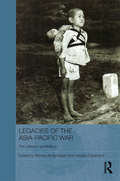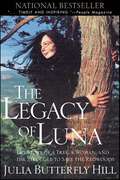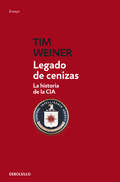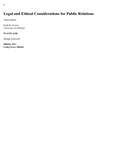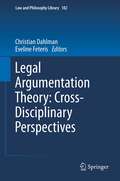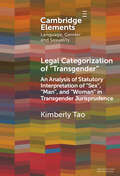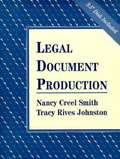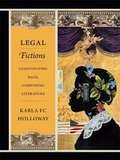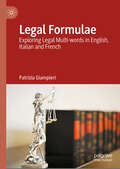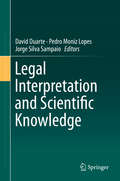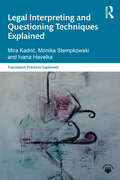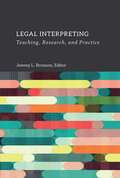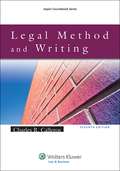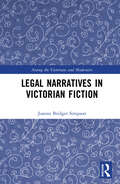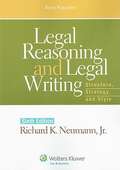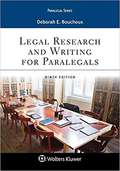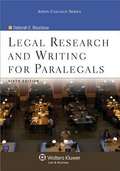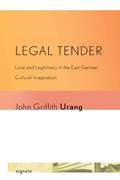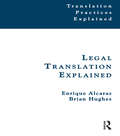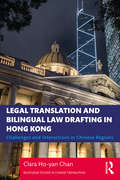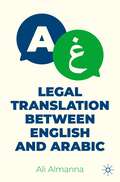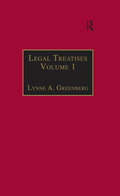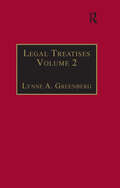- Table View
- List View
Legacies of the Asia-Pacific War: The Yakeato Generation (Routledge Contemporary Japan Series)
by Yasuko Claremont Roman RosenbaumWhen we look in detail at the various peripheral groups of disenfranchised people emerging from the aftermath of the Asia–Pacific War the list is startling: Koreans in Japan (migrants or forced labourers), Burakumin, Hibakusha, Okinawans, Asian minorities, comfort women and many others. Many of these groups have been discussed in a large corpus of what we may call ‘disenfranchised literature’, and the research presented in this book intends to add an additional and particularly controversial example to the long list of the voice- and powerless. The presence of members of what is known as the yakeato sedai or the generation of people who experienced the fire-bombings of the Asia–Pacific War is conspicuous in all areas of contemporary Japan. From literature to the visual arts, from music to theatre, from architecture to politics, their influence and in many cases guiding principles is evident everywhere and in many cases forms the keystone of modern Japanese society and culture. The contributors to this book explore the impact of the yakeato generation - and their literary, creative and cultural and works - on the postwar period by drawing out the importance of the legacy of those people who truly survived the darkest hour of the twentieth century and re-evaluate the ramifications of their experiences in contemporary Japanese society and culture. As such this book will be of huge interest to those studying Japanese history, literature, poetry and cultural studies.
Legacies of the Sublime: Literature, Aesthetics, and Freedom from Kant to Joyce (SUNY series, Studies in the Long Nineteenth Century)
by Christopher KitsonLegacies of the Sublime offers a highly original, subtle and persuasive account of the aesthetics of the sublime in late nineteenth- and early twentieth-century literature, philosophy, and science. Christopher Kitson reveals the neglected history of how Kant's theory of the sublime in the Critique of Judgment cast a shadow over the next century and more of literature and thought. In each chapter, close readings weave together literary works with philosophical and scientific ones in order to clarify the complex dialogues between them. Through these readings, Kitson shows how the sublime survived well after the heyday of romanticism as a way of representing human freedom. This new context produces fresh interpretations of canonical literary works, by Thomas Carlyle, H. G. Wells, Joseph Conrad, and James Joyce, with reference to important theoretical texts by Karl Marx and Friedrich Engels, Arthur Schopenhauer, Friedrich Nietzsche, and Sigmund Freud. Kitson follows the sublime's various manifestations and mutations, through the nineteenth century's industrial grandeur and the vertiginous prospects of deep time, into the early twentieth century's darkly ironic and uncanny versions. A welcome contribution to the study of the long nineteenth century, this work reveals an unexamined chapter in intellectual history and in the story of the modern self.
Legacy of Luna: The Story of a Tree, a Woman, and the Struggle to Save the Redwoods
by Julia Butterfly HillOn December 18, 1999, Julia Butterfly Hill's feet touched the ground for the first time in over two years, as she descended from "Luna," a thousandyear-old redwood in Humboldt County, California.Hill had climbed 180 feet up into the tree high on a mountain on December 10, 1997, for what she thought would be a two- to three-week-long "tree-sit." The action was intended to stop Pacific Lumber, a division of the Maxxam Corporation, from the environmentally destructive process of clear-cutting the ancient redwood and the trees around it. The area immediately next to Luna had already been stripped and, because, as many believed, nothing was left to hold the soil to the mountain, a huge part of the hill had slid into the town of Stafford, wiping out many homes.Over the course of what turned into an historic civil action, Hill endured El Nino storms, helicopter harassment, a ten-day siege by company security guards, and the tremendous sorrow brought about by an old-growth forest's destruction. This story--written while she lived on a tiny platform eighteen stories off the ground--is one that only she can tell.Twenty-five-year-old Julia Butterfly Hill never planned to become what some have called her--the Rosa Parks of the environmental movement. Shenever expected to be honored as one of Good Housekeeping's "Most Admired Women of 1998" and George magazine's "20 Most Interesting Women in Politics," to be featured in People magazine's "25 Most Intriguing People of the Year" issue, or to receive hundreds of letters weekly from young people around the world. Indeed, when she first climbed into Luna, she had no way of knowing the harrowing weather conditions and the attacks on her and her cause. She had no idea of the loneliness she would face or that her feet wouldn't touch ground for more than two years. She couldn't predict the pain of being an eyewitness to the attempted destruction of one of the last ancient redwood forests in the world, nor could she anticipate the immeasurable strength she would gain or the life lessons she would learn from Luna. Although her brave vigil and indomitable spirit have made her a heroine in the eyes of many, Julia's story is a simple, heartening tale of love, conviction, and the profound courage she has summoned to fight for our earth's legacy.
Legado de cenizas: La historia de la CIA
by Tim WeinerLa primera historia completa de la CIA. Durante los últimos sesenta años, la CIA ha conseguido mantener una excelente reputación a pesar de su terrible trayectoria, escondiendo sus errores en archivos de alto secreto. Ahora, Tim Weiner, ganador del Pulitzer por sus trabajos periodísticos sobre los servicios secretos estadounidenses, nos ofrece la historia definitiva de la CIA. A partir de más de cincuenta mil documentos y cientos de entrevistas, Legado de cenizas reconstruye la apasionante historia de la agencia secreta más famosa y temida del mundo, desde su creación tras la Segunda Guerra Mundial hasta el colapso del 11 de septiembre. Una obra fundamental para entender la segunda mitad del siglo xx. ** Ganador del National Book Award de no ficción. ** Mejor libro de historia de 2007 para Los Angeles Times. ** Finalista del National Book Critics Circle Award de no ficción Reseñas:«Sin este Legado de cenizas no se puede entender el siglo XX; seguramente, tampoco el siglo XXI.»El País «El relato trepidante y documentado de una realidad que supera a cualquier ficción.»ABC «Realmente extraordinario, el mejor libro que se ha escrito nunca sobre espionaje.»The Wall Street Journal «Magistral, un trabajo brillante.»Los Angeles Times «Apasionante, no deja cabos sueltos.»The New York Times «Un triunfo tanto del periodismo como de la historia.»Washington Post
Legal And Ethical Considerations For Public Relations
by Karla K. GowerPublic relations frequently reflects the conscience of an organization. Public relations professionals must ask the right questions when advising organizations on the best ways to protect themselves from damage or liability. A better understanding of ethics helps formulate those questions and educate management on the ethical consequences of corporate action.
Legal Argumentation Theory: Cross-Disciplinary Perspectives
by Christian Dahlman Eveline FeterisThis book offers its readers an overview of recent developments in the theory of legal argumentation written by representatives from various disciplines, including argumentation theory, philosophy of law, logic and artificial intelligence. It presents an overview of contributions representative of different academic and legal cultures, and different continents and countries. The book contains contributions on strategic maneuvering, argumentum ad absurdum, argumentum ad hominem, consequentialist argumentation, weighing and balancing, the relation between legal argumentation and truth, the distinction between the context of discovery and context of justification, and the role of constitutive and regulative rules in legal argumentation. It is based on a selection of papers that were presented in the special workshop on Legal Argumentation organized at the 25th IVR World Congress for Philosophy of Law and Social Philosophy held 15-20 August 2011 in Frankfurt, Germany.
Legal Categorization of 'Transgender': An Analysis of Statutory Interpretation of 'Sex', 'Man', and 'Woman' in Transgender Jurisprudence (Elements in Language, Gender and Sexuality)
by Kimberly TaoThis Element analyzes the foundational frame of legal reasoning when courts interpret the 'plain language' and 'ordinary meaning' of terms such as 'sex', 'man' and 'woman'. There is a rich and complicated line of cases on how to define these terms and how to legally categorize transgender people. When dealing with different legal issues, judges need to give a clear 'yes' or 'no', determinate answer to a legal question. Marginal categorizations could be problematic even for experts. It analyses nine decisions that relate to transgender people's workplace protection under Title VII in United States and the right to marry in United Kingdom and Hong Kong. It brings in a historical discussion of the development of interpretative practices of law and legal categorization of transgender individuals across past decades, drawing on the intricate relationship between time and statutory interpretation.
Legal Document Production
by Nancy Creel Smith Tracy Rives JohnstonThis combination book/workbook/reference provides a well-rounded overview of the procedures to follow in producing legal documents in six areas of law, general legal correspondence, and miscellaneous documents. Readers gain hands-on experience formatting and producing documents using any software package, word processor, electronic typewriter, or standard typewriter. The book provides a realistic approach to the procedural process required in the court system; features a wide variety of hands-on projects that focus on the documents themselves-- i. e. , the projects are suitable for any word processing software used with a computer, electronic typewriter, word processor, or standard typewriter; includes projects that highlight the documents from a variety of states, including specific features of California, Florida, Illinois, New York, Ohio, Texas, Virginia.
Legal Education and Legal Traditions: Selected Essays (SpringerBriefs in Environment, Security, Development and Peace #34)
by Myint ZanThis book deals with aspects of legal education and legal traditions. Part I includes chapters on teaching Law of the Sea, legal ethics and educating lawyers as ‘transaction cost engineers’ as well as comparison of teaching law in a refugee camp and in a Malaysian University. Part II on legal and philosophical traditions includes essays on what later philosophers would have commented on Plato’s arguments in the Crito regarding ‘absolute obligation to obey the law’ and what Socrates would have said on two conversations in the 19th century novel Uncle Tom’s Cabin regarding the morality and legality of harbouring runaway slaves. Part II concludes with two essays regarding the applicability of the Hart-Devlin debate on the ‘enforcement of morals’ vis-à-vis the International Criminal Court and an essay on what the historian Arnold Toynbee would have commented on the ‘contingency’ v ‘teleology’ debate between two palaeontologists the late Stephen Jay Gould and Simon Conway Morris.• Legal education of interest to legal educators and students • Legal, political, moral philosophy as well as philosophy of history of interest to law, philosophy and history teachers, postgraduate and under graduate students• Aspects of legal ethics for law teachers, students and legal professionals• Interdisciplinary studies regarding law and economics, law and literature, law and social justice for law, humanities, social science academics and students.
Legal Fictions: Constituting Race, Composing Literature
by Karla Fc HollowayIn Legal Fictions, Karla FC Holloway both argues that U.S. racial identity is the creation of U.S. law and demonstrates how black authors of literary fiction have engaged with the law's constructions of race since the era of slavery. Exploring the resonance between U.S. literature and U.S. jurisprudence, Holloway reveals Toni Morrison's Beloved and Charles Johnson's Middle Passage as stories about personhood and property, David Bradley's The Chaneysville Incident and Ralph Ellison's Invisible Man as structured by evidence law, and Nella Larsen's Passing as intimately related to contract law. Holloway engages the intentional, contradictory, and capricious constructions of race embedded in the law with the same energy that she brings to her masterful interpretations of fiction by U.S. writers. Her readings shed new light on the many ways that black U.S. authors have reframed fundamental questions about racial identity, personhood, and the law from the nineteenth into the twenty-first centuries. Legal Fictions is a bold declaration that the black body is thoroughly bound by law and an unflinching look at the implications of that claim.
Legal Formulae: Exploring Legal Multi-words in English, Italian and French
by Patrizia GiampieriThis book analyses and investigates the neutral legal formulae of the English common law and the Italian and French civil law traditions, together with those used in international settings such as the European Union. It explores the usage of English formulae (and of their Italian and French counterparts) that are mentioned in terms of service, national and EU legislation, and in national and European parliamentary debates. The author takes a comparative approach to analysing the various corpora, carrying out cross-analyses to allow understanding of the usage(s) in contexts of neutral legal formulae. This reveals insights into word frequencies in the three languages and legal systems, as well as in different genres, and the book goes on to compare the relative frequencies of the neutral formulae across the three languages to investigate their variety. This book will be of interest to academics, students and practitioners in fields including linguistics, law, and corpus-based legal translation.
Legal Interpretation and Scientific Knowledge
by David Duarte Jorge Silva Sampaio Pedro Moniz LopesThis book discusses the question of whether legal interpretation is a scientific activity. The law’s dependency on language, at least for the usual communication purposes, not only makes legal interpretation the main task performed by those whose work involves the law, but also an unavoidable step in the process of resolving a legal case. This task of decoding the words and sentences used by normative authorities while enacting norms, carried out in compliance with the principles and rules of the natural language adopted, is prone to all of the difficulties stemming from the uncertainty intrinsic to all linguistic conventions. In this context, seeking to determine whether legal interpretation can be scientific or, in other words, can comply with the requirements for scientific knowledge, becomes a central question. In fact, the coherent application of the law depends on a knowledge regarding the meaning of normative sentences that can be classified (at least) as being structured, systematically organized and tendentially objective. Accordingly, this book focuses on analyzing precisely these problems; its respective contributions offer a range of revealing perspectives on both the problems and their ramifications.
Legal Interpreting and Questioning Techniques Explained (Translation Practices Explained)
by Mira Kadrić Monika Stempkowski Ivana HavelkaLanguage and law are closely linked, and language is fundamental to the application of the law. Legal, criminalistic, translational and psychological aspects of communication come together in interpreted questioning (hearings, interrogations, interviews) and must be taken into account, especially since the way in which the questioning outcomes are evaluated can have far-reaching legal consequences. Building on empirical studies and practice, this accessible text provides a transdisciplinary examination of questioning methods and strategies. The institutional framework conditions of a questioning situation are examined in the context of transdisciplinary cooperation.This book also addresses the increasing use of technology and hybrid forms of translation and interpreting in the legal system, and shows different ways in which interpreters co-construct information. Chapters include summaries of key concepts and definitions, examples from existing literature combined with practical experience and the results of surveys conducted by the authors, as well as further reading and non-language-specific study activities. Activities include role plays on thematic scenarios involving different actors in criminal proceedings and discussion groups to enable reflection on ethical issues and discursive challenges.This is a vital text for both advanced students and professionals in interpreting studies and criminology.
Legal Interpreting: Teaching, Research, and Practice (The Interpreter Education Series #12)
by Jeremy L. BrunsonLinguistic minorities are often severely disadvantaged in legal events, with consequences that could impact one’s very liberty. Training for interpreters to provide full access in legal settings is paramount. In this volume, Jeremy L. Brunson has gathered deaf and hearing scholars and practitioners from both signed and spoken language interpreting communities in the United States, Canada, and the United Kingdom. Their contributions include research-driven, experience-driven, and theoretical discussions on how to teach and assess legal interpreting. The topics covered include teaming in a courtroom, introducing students to legal interpreting, being an expert witness, discourses used by deaf lawyers, designing assessment tools for legal settings, and working with deaf jurors. In addition, this volume interrogates the various ways power, privilege, and oppression appear in legal interpreting. Each chapter features discussion questions and prompts that interpreter educators can use in the classroom. While intended as a foundational text for use in courses, this body of work also provides insight into the current state of the legal interpreting field and will be a valuable resource for scholars, practitioners, and consumers.
Legal Method And Writing
by Charles CallerosHighly regarded and classroom-proven, the Legal Method and Writing takes a comprehensive approach to legal writing that bridges law school and law office. Exercises and real-life examples--many taken from actual cases--provide stepping-off points from which to practice legal thinking and communication. Calleros seamlessly weaves multicultural themes into many of the problems and examples to add context and enrich student understanding of legal issues.
Legal Narratives in Victorian Fiction (Among the Victorians and Modernists)
by Joanne Bridget SimpsonThe law holds up a mirror to society and reflects that society and its ongoing preoccupations. This book establishes legal interpretation as a mode of literary interpretation, contextualising the opinions and sociological background of literature within the context of the law of its period and examines the inherent role of the law in the construction of the narrative in the literature of the nineteenth century. From the approach to the operation of jurisprudence and legal application, to the prosecution of the poor, the criminological approach to moral panics and the use of the affirmative defence to mitigate women within society, this book explores the ways in which the authors of the period used the novel form as a way of challenging and critiquing the legal operating model of the world in which their characters found themselves; examining the way in which the authors of the period used the novel as a means of critiquing the nature of the role of the law within society, its impact upon the general public, and the reciprocity which exists between legal ideals and the society which manifests those ideals through thought and action. This is a useful text for students of nineteenth-century literature or the law.
Legal Reasoning and Legal Writing: Structure, Strategy, and Style (6th edition)
by Richard K. NeumannThe Sixth Edition of this respected and popular text remains grounded in the premise that legal reasoning and legal writing are best learned when they are taught together. Building on that foundation, Neumann continues to offer complete, clear, and timely coverage of how to form a legal argument and how to write an effective legal memorandum. Streamlined in its Sixth Edition, Legal Reasoning and Legal Writing features: comprehensive coverage of legal writing: the office memo; the motion memo; the appellate brief; eminently readable text, including an exceptionally lucid explanation of the reasoning behind the proof of a conclusion of law; a thoughtful treatment of all aspects of legal reasoning; student-friendly instruction on the process of writing, the mechanics of style, and grammar up-to-date examples and exercises; sample documents in the Appendices, including an office memo, motion memo, and two appellate briefs. Highly regarded author Richard K. Neumann, Jr. presents, in tandem, smart, in-depth coverage of legal writing and legal reasoning, supported by examples, writing samples, and extraordinarily clear and lucid exposition.
Legal Research And Writing For Paralegals
by Deborah E. BouchouxLegal Research and Writing for Paralegals emphasizes the skills and issues that paralegals encounter in practice. Thoroughly up-to-date, the Ninth Edition continues to combine clear text with visual aids, writing samples, tips, and pointers. Designed specifically for paralegal students, Deborah Bouchoux s classroom-tested approach teaches cutting-edge research skills, writing style, and proper citation form to equip students with an essential skill set and well-founded confidence. <p><p> The author's logical and comprehensive approach enhances students understanding. Part I covers Primary Authorities, Part II discusses Secondary Authorities, and Part III covers the basics of Legal Writing. In addition, Bouchoux integrates writing strategies into each research chapter to demonstrate the link between the two processes. Thorough coverage of electronic research includes chapters on both internet research and fee-based services. Bouchoux thoroughly explains proper citation form and the process of updating/validating legal authorities. The Legal Writing section includes samples of legal writing, such as letters, a court brief, and a legal memorandum.
Legal Research and Writing For Paralegals (Sixth Edition)
by Deborah E. BouchouxFocusing on the issues that paralegals face on the job, Legal Research and Writing for Paralegals presents an organized and practical introduction to legal research and writing. The carefully updated Sixth Edition takes a close look at new products and developments in electronic research while continuing to build on the strength of its pedagogy. A comprehensive overview enriched by illustrations and exercises, this text features: * an approach that integrates writing strategies into research chapters to show the link between these two processes * thorough coverage of electronic research, with a chapter on Internet research and fee-based services, such as Lexis and Westlaw * pointers throughout for using electronic resources more effectively * helpful charts and diagrams that clearly illustrate complex topics * Practice Tips in each chapter that offer realistic and helpful suggestions for workplace success * State Your Answer exercises that help students learn how to navigate through cyberspace * Internet Assignmentswhich can be made state-specific;that give students practice finding information on-line * step-by-step guidance for proper citation formkeyed to the fourth edition of ALWD and the new 19th edition of The Bluebook * directions for how to update and validate legal authorities * samples of legal writing, such as letters, a court brief, and a legal memorandum Updated throughout, the new Sixth Edition gives you more: * expanded coverage of electronic research * how to use "Google Scholar" to locate cases * how to access government documents from GPO Access to FDsys * the new features from Westlaw and Lexis, including WestlawNext, the new "intuitive platform" the new Easy Search feature, and Case in Brief * Fastcase, the fee-based, computer-assisted system, its free "app" for iPhones, and other law-related apps * a new assignment that uses Loislaw * a new assignment that compares Shepardize and KeyCite * new sample pages
Legal Tender
by John Griffith UrangTreating films including Leander Hauss/mann's controversial Sonnenalle (1999), Urang (visiting professor of German, Reed College, Portland, Oregon) explores the question of why in so many East German films and novels love trumps the crumbling political culture of the GDR. Citing Niklas Luhmann's Love as Passion: The Codification of Intimacy as a key influence, he examines how the "semantics of love" interact with socialist-realist processes of authoritarianism. While these love stories draw on the Western tradition, they also critique bourgeois romantic love institutions and practices--a metaphor for reunification with West Germany. Annotation ©2011 Book News, Inc. , Portland, OR (booknews. com)
Legal Translation Explained (Translation Practices Explained)
by Brian Hughes Enrique Alcaraz Anthony PymFocusing on the problems of translating English legal language, Alcaraz and Hughes offer a wide-ranging view of one of the most demanding and vital areas of contemporary translation practice. Individual chapters deal with legal English as a linguistic system, special concepts in the translation of legal English, the genres of legal translation, and offer a series of practical problems together with discussions of proposed solutions, as well as insight into the pragmatic ways translators go about finding solutions. The numerous examples and discussions of specific terms make the book useful both as a manual in the translation class and as an invaluable reference work for students, teachers, self-learners and professional translators.
Legal Translation and Bilingual Law Drafting in Hong Kong: Challenges and Interactions in Chinese Regions (Routledge Studies in Chinese Translation)
by Clara Ho-yan ChanLegal Translation and Bilingual Law Drafting in Hong Kong presents a systematic account from a cross-disciplinary perspective of the activities of legal translation and bilingual law drafting in the bilingual international city of Hong Kong and its interaction with Mainland China and Taiwan in the use of legal terminology. The study mainly examines the challenges posed to English-Chinese translation in the past three decades by elaborate drafting and terminological equivalence, and offers educational and research solutions. Its primary goals are to create legal Chinese that naturally accommodates common law concepts and statutes from the English legal system and to reconcile Chinese legal terms from the different legal systems adopted by Hong Kong, Mainland China and Taiwan. The new directions in legal translation and bilingual law drafting in Hong Kong will have implications for other Chinese regions and for the world. The book is intended for scholars, researchers, teachers and students of legal translation and legal linguistics, legal translators, lawyers and legal practitioners who are engaged in translation, as well as all persons who are interested in legal language and legal translation.
Legal Translation between English and Arabic
by Ali AlmannaThis is a coursebook designed for students of translation, which will also benefit professional translators as it covers key issues in contemporary legal translation. The book is divided into two main parts. The first, theoretical part, explores issues such as types of legal texts, readership, communicative purpose, global and local strategies, and modality in addition to analysing the common features of legal discourse in both languages, be they lexical, syntactic, or textual. The second, practical part, discusses issues such as legal rights, contractual obligations, torts, crimes, people and law. It focuses on all types of legal texts, regardless of their classification and examines legislative texts, which have acquired a certain degree of notoriety rarely equalled by any other variety of English.
Legal Treatises: Essential Works for the Study of Early Modern Women, Series III, Part One, Volume 1 (The Early Modern Englishwoman: A Facsimile Library of Essential Works for the Study of Early Modern Women Series III, Part One #Vols. 1-3)
by Lynne A. GreenbergThe texts reproduced in facsimile in the three volumes of 'Legal Treatises' reconstruct the legal status of the early modern Englishwoman. To facilitate a reading of the treatises by broadly defining many of the laws discussed in great detail in the treatises, a general introduction to the laws of the period provides concise overviews of the structure of the English legal system; the legal education of practitioners of the law; the kinds of legal literature produced in the period; and the legal position of early modern Englishwomen. A bibliography of important secondary scholarship devoted to the early modern Englishwoman's legal position assists the reader in obtaining more specialized knowledge. In addition to the general introduction, a separate introduction to each of the reproduced works is provided, including information about each work's publication and authorship, intended audience, content and reception. In order to provide this framework for the years 1600-1750, this first volume of 'Legal Treatises' reproduces The Lawes Resolutions of Womens Rights (1632), the first known treatise devoted to the legal rights of women. 'The Womans Lawyer,' as the treatise's running headline and spine title read, was published anonymously in 1632; the title page fails to identify the original author of the work, and its authorship remains in question today. At over 400 pages, the text represents a massive effort of consolidation, organizing the disparate and hitherto uncompiled aspects of the common law applicable to women into a logical framework. It is unusual among early modern legal treatises in its stated goal of providing a 'popular kind of instruction' to its readers.
Legal Treatises: Essential Works for the Study of Early Modern Women: Series III, Part One, Volume 2 (The Early Modern Englishwoman: A Facsimile Library of Essential Works for the Study of Early Modern Women Series III, Part One)
by Lynne A. GreenbergThe texts reproduced in facsimile in the three volumes of 'Legal Treatises' reconstruct the legal status of the early modern Englishwoman. To facilitate a reading of the treatises by broadly defining many of the laws discussed in great detail in the treatises, a general introduction to the laws of the period provides concise overviews of the structure of the English legal system; the legal education of practitioners of the law; the kinds of legal literature produced in the period; and the legal position of early modern Englishwomen. A bibliography of important secondary scholarship devoted to the early modern Englishwoman's legal position assists the reader in obtaining more specialized knowledge. In addition to the general introduction, a separate introduction to each of the reproduced works is provided, including information about each work's publication and authorship, intended audience, content and reception. In order to provide this framework for the years 1600-1750, this first volume of 'Legal Treatises' reproduces The Lawes Resolutions of Womens Rights (1632), the first known treatise devoted to the legal rights of women. 'The Womans Lawyer,' as the treatise's running headline and spine title read, was published anonymously in 1632; the title page fails to identify the original author of the work, and its authorship remains in question today. At over 400 pages, the text represents a massive effort of consolidation, organizing the disparate and hitherto uncompiled aspects of the common law applicable to women into a logical framework. It is unusual among early modern legal treatises in its stated goal of providing a 'popular kind of instruction' to its readers.
